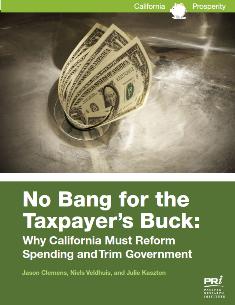California Government Spending
The estimate for California’s total state spending in 2009–10 is $125.1 billion, of which General Fund spending constitutes 69.1 percent. Total state spending (nominal) has increased from $75.3 billion in 1998–99 to $125.1 billion in 2009–10 (an increase of 66.2 percent). The increases over this period outpaced population growth and inflation in seven of the 11 years recorded and outstripped economic growth in seven of the nine years recorded. If growth in total state spending over the last decade were limited to an amount required to maintain 1998–99 levels given population growth and inflation, total spending would be $9.7 billion lower than today, more than half the current estimated deficit.
Direct state government spending is not limited to the General Fund, which reached $86.5 billion in 2009–10. California also spends through the Special Fund and Bond Fund. State spending is dominated by education and health and human services regardless of whether only General Fund or total state spending is examined. The main reason for the state’s ongoing deficit problem is overspending.
Include Local Spending
According to the Bureau of Economic Analysis, total state and local government spending in California increased from $180.9 billion in 1999 to $335.3 billion in 2008 (the most recent year available), an increase of 85.4 percent. Compare the actual level of spending against what was required to maintain 1999 spending levels, adjusting for population growth and inflation. The gap between the two in 2008 was an astounding $70.3 billion.
The growth in total state and local spending exceeded the growth in population and increase in the price level in California in eight of the nine years examined (1999 to 2008). The growth in state and local spending exceeded nominal GDP growth in five of the nine years: it was more than double in 2000–01, and more than four times the rate of GDP growth in 2001–02. Increases of such magnitude are simply not sustainable.
California – Size of Government
The best measure to assess the size of government is to compare government spending to the economy (GDP). In 2008, California ranked 41st among the 50 states with state and local government spending at 22.3 percent of state GDP (GSP). This level of spending was more than 10 percent higher than the national average. Delaware was the state with the smallest state and local government at 14.7 percent of GSP. Texas ranked second at 15.4 percent. Mississippi maintained the largest state and local government among all 50 states at 27.4 percent of GSP.
In 2008, California ranked 20th among the 50 states in terms of federal, state, and local government spending at 36.9 percent of GSP. Government spent more than one in three dollars of GDP in California. California’s ranking on the size of federal, state, and local government is better than its ranking on state and local government. This occurs because federal spending as a percent of GSP in California is significantly less than it is in many other states.
California Government Relative to the Optimal Size
Richard Vedder and Lowell Gallaway estimated the growth-maximizing size of state and local governments at approximately 11.4 percent of GDP.1 With state and local government spending at 22.3 percent of GSP, California’s state and local government spending is nearly double the optimal, growth-maximizing level, even if federal spending is included.
Estimates of the optimal size of government (federal, state, and local) in the United States range from 15 to 25 percent of GDP. Using the upper end of the range as a conservative estimate, total government (federal, state, and local) spending in California (36.9 percent of GDP) is significantly above the optimal level.
Economic Research on the Size of Government
A broad summary of the research on the economic effects of government spending shows that many governments operate where they are not needed. The resources expended, along with the taxes to finance them, do not contribute to economic growth. Government beyond the optimal level contributes little, if anything, to economic prosperity and social progress. At a little more than 40 percent of GDP, total government spending in the United States is clearly much greater than any of the specific estimates for economic-growth maximization or social progress.
Government Performance in California
California maintains one of the largest governments in the country, but what are Californians receiving for such large expenditures? This study relied on academic work comparing country-level performance across an array of services including health care and education.2 California’s government performance was compared to 23 industrialized (OECD) countries, including the United States as a whole, in three measures.
(1) Government Performance
Government (public sector) performance is defined as the outcome of government activities. Several outcome indicators in areas such as education, health, public infrastructure, economic stability, and economic performance were analyzed. California ranked 22nd among the 24 jurisdictions with an overall score of 0.88, where 1.00 was the average.
(2) Government Efficiency
This category evaluates the performance of government on each indictor compared to the amount of government spending for that area. California ranked 15th among the 24 jurisdictions with an overall score of 0.99, slightly below average (1.00). The United States as a whole was above average with a score of 1.09.
California’s government is less efficient in achieving its distribution (0.81), stability (0.89), health care (0.89), and education (0.92) objectives than the 24 jurisdiction average. The only area in which California scored above average was economic performance.
(3) Expenditure Efficiency
This measure looked at the efficiency of governments across the 24 jurisdictions to determine the “wastefulness” of government spending. California received an output efficiency score of 0.72 and a ranking of 21st out of the 24 jurisdictions examined. The score implies that with the current level of government spending, California’s government performance is 72 percent of what it could be if it were providing services efficiently. The United States as a whole received a score of 0.80.
Reform Studies
The study summarizes several prominent empirical studies. These indicate a tremendous opportunity for California to do more with less. What is needed now is leadership to put California back on course.
Conclusion and Recommendations
The evidence is powerfully persuasive that government in California has grown too large and inefficient. Reducing the size of government in California is a foundational component of economic renewal. The programs and services that survive need to ensure better value for taxpayers. We suggest subjecting every state and local government department to the following tests:
1) Assess whether each program and department operates in an area in which government is required and whether it is affordable.
2) If government participation is required, what is the level of government, closest to the people, that is best able to efficiently deliver the program or service? Research has consistently shown that services delivered by governments closest to the people are more efficient and less susceptible to corruption and capture by special interests.
3) What is the proper role for the public and private sectors in each of these areas? The reality is that there is a spectrum of opportunities for both the public and private sectors to participate. The key is to determine the proper mix of the two sectors in each area to achieve efficiency.
These criteria provide a broad framework for evaluating current spending, prioritizing programs and services, and identifying areas for reform. Spending reform is the foundation for downsizing government, achieving a sustainably balanced budget, and restoring prosperity to the Golden State.


